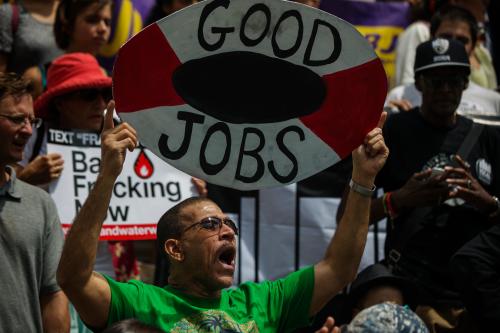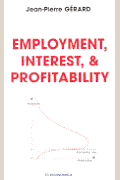Can we bribe employers to increase their payrolls? Many economists, including me, think we can and should, particularly when the job market is in the doldrums. The crucial question is how to design the bribe so it is as cheap and effective as possible.
The current unemployment rate is over 8 percent, where it has languished for the past 36 months. While unemployment has fallen since last summer, there remains an immense gulf between the number of Americans who are employed and the number who would hold jobs if the economy were operating at full potential. I estimate this gap to be more than 10 million workers.
Given the current state of the job market, unemployed workers face unprecedented challenges finding work. Their lengthy spells without employment represent a vast waste of human potential. Experience from past recessions suggests the career interruptions suffered by jobless workers can reduce their potential earnings for a decade or more.
The most important question facing policymakers is how to speed up the pace of hiring and accelerate the tempo of the recovery. One idea pushed by economists is to establish a temporary tax subsidy for employers who add to their payrolls. The reasoning behind this idea is that by trimming the cost of hiring added workers, the government can induce employers to boost the ranks of the employed.
This idea was tried in 2010 when Congress passed the HIRE (Hiring Incentives to Restore Employment) Act. The law gave businesses an exemption from Social Security payroll taxes for every worker hired in 2010 who was unemployed for at least 60 days. The maximum value of the incentive was 6.2% of 2010 wages, up to the taxable wage cap of $106,800. Businesses received an additional $1,000 credit for every new employee kept on payrolls for at least 52 weeks. The estimated cost of the HIRE Act was $13 billion.
The same idea was also tried earlier, in the recovery from the 1974-75 recession. The goal of the 1977 NJTC (New Jobs Tax Credit) was to encourage job growth by giving a subsidy for new hires that increased a company’s payroll above 102% of the payroll level in the previous year. The credit gave subsidies to employers for net employment growth in 1977 and 1978. For a company that claimed the credit, the NJTC reduced the average cost of a subsidized worker by about 20% or 25%. In other words, the credit reduced by up to one-quarter the net cost to profit-making employers of putting subsidized workers on their payrolls. Unfortunately, a cap on the maximum credit payable to a single employer drastically reduced the employment expansions covered by the credit.
It would be nice to think we learn from our mistakes. The history of employment tax credits provides only weak evidence in support of this proposition. Our experience with past employment credits suggests they should be easy to understand, inexpensive to administer, targeted on encouraging payroll expansion, and designed to minimize payments to employers for hiring that would have occurred without the credit. Employment credits enacted in the past have embodied some, but not all, of these lessons.
A simple way to minimize payments to employers is to limit subsidies to those workers who represent net additions to an employer’s payroll. If an employer had 100 workers on its payroll last year, it must have at least 101 this year before obtaining any subsidy. For most employers, this requirement is straightforward to enforce because payrolls must be reported to the unemployment insurance system on a regular basis. Employers may be tempted to boost their payrolls by reducing the work hours assigned to each employee. To minimize this risk, the tax subsidy can be targeted on employers who maintain quarterly average wages within a fixed percentage of the previous year’s average wage.
A major challenge is to design a credit that is easy for employers to understand and cheap to administer. One approach is to structure the subsidy as a cut in a tax that nearly all employers must pay. An obvious tax of this kind is the employer contribution for Social Security and Medicare. For workers who earn less than $106,800, the employer tax is 7.65% of a worker’s wage. Thus, a simple hiring subsidy is one that eliminates the employer payroll tax contribution on wages paid to workers who represent net new hires, that is, who increase the employer’s total payroll. (To protect the Social Security and Medicare programs, the payroll tax losses of the Trust Funds should be made up with transfers from general revenues.)
Tight limits on the hiring subsidy to reduce employer abuses tend to make the subsidy more complicated, reduce employers’ participation, and increase the government’s cost of administration. On the other hand, dramatic simplifications can unnecessarily increase the cost of the subsidy without increasing its effect on employment. For example, if we temporarily eliminate the payroll tax on the wages of all new hires, an overwhelming percentage of credit payments will go to subsidizing employment that would have occurred in the absence of the credit. Millions of new hires and terminations occur every month, whether the economy is lagging or is expanding robustly. It makes no sense to subsidize the new hires of high-turnover employers unless they are adding to the size of their payrolls over the course of a year.
Crafting a well-designed employment subsidy is not easy, but it is not impossible either. Hiring subsidies are a more promising approach to employment expansion than many of the stimulus measures we have tried. If voters and lawmakers are worried about adding to the national debt, we should adopt stimulus measures that are as economical as possible while still addressing the central problem of high joblessness. Providing a simple, but temporary subsidy for additions to company payrolls can boost employers’ willingness to hire.









Commentary
Op-edA Partial Remedy for an Ailing Job Market
March 5, 2012